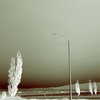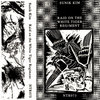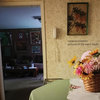Formenverwandler by Sunik Kim

Beyond excited to announce the new album Formenverwandler by Sunik Kim, a Los Angeles-based musician, writer and filmmaker who has previously released music on Notice Recordings, Rope Editions and OTOROKU. Spanning almost 2 hours, Formenverwandler is a detailed and considered study on time and duration.
Drawing from her extensive research on composer Conlon Nancarrow, Formenverwandler sees Kim exploring the time or tempo canon, which can pull and project the listener's senses, melting the temporal and spatial perception of presented sounds. As in previous works such as 2022’s Raid on the White Tiger Regiment and 2023’s Potential, Kim deploys patches and tools she has designed for SuperCollider, which take raw, utilitarian General MIDI notes and multiply and spray them into frenetic webs and networks of spiraling sound.
It is within these networks that sounds, recognisable and familiar, are placed, scattered and gathered into new structures that appear to shapeshift, constantly morphing in meter. The album's title Formenverwandler (German for shapeshifter, taken from the classic Der Zyklus track) perfectly encapsulates this collection of pieces that are in constant motion and in a state of reflection and restructure. The four pieces are mirrors and refolds of one another, both stretched and condensed in various directions and examined to the point of near exhaustion.
Along with the music, Kim has written an essay which outlines the thoughts, actions and reflections that make up this body of work. Reading the essay—and rereading it—is an endlessly insightful way of entering and understanding the headspace that produced this deeply considered music and its inner ecology. Along with rationale and reasoning, Kim interjects quotes from writers, poets and thinkers—from Lenin to Woolf—who have ruminated on and have existed within the confines of time.
The album will be available physically and digitally, with a copy of Kim's Formenverwandler essay available with both, or available to read freely below, both on Bandcamp and via the link.
https://sunikkim.com/formenverwandler
----------------
An hour, once it lodges in the queer element of the human spirit, may be stretched to fifty or a hundred times its clock length; on the other hand, an hour may be accurately represented on the timepiece of the mind by one second.
—Virginia Woolf, Orlando
Human knowledge is not (or does not follow) a straight line, but a curve, which endlessly approximates a series of circles, a spiral.
—V.I. Lenin, “On the Question of Dialectics”
These successive deaths, so feared by the self which they were destined to annihilate, so painless, so unimportant once they were accomplished and the self that feared them was no longer there to feel them, had taught me by now that it would be the merest folly to be frightened by death.
—Marcel Proust, Time Regained
Time is the last frontier of music.
—Conlon Nancarrow
The kernel of this work was an intensive months-long dissection of Nancarrow’s studies for player piano—specifically his use of the time or tempo canon, where the same melodic fragment is layered upon a slowed, sped-up, accelerating or decelerating version of itself, resulting in bizarre temporal-perceptual effects. This led to a series of experiments where I pushed my SuperCollider program to generate time-canonic structures through electronic sounds.
I noticed that these fragments, at high speeds, melted timbre and rhythm into one another, presenting the listener with a chaotic yet temporally rigorous musical structure in constant motion. Critically, with sufficient volume these fragments tickled my ear in ways not so dissimilar from Amacher’s Sound Characters. This was further confirmed when I tested the material in live settings on quality loudspeakers: feedback from audience members consistently focused on the music’s corporeal effects and its distortion of perceptual time. This took the canon as materialization or measure of time to another level of sensuous intensity.
My growing interest in temporal distortion necessitated duration. In stretching far past my comfortable half-hour range, I wanted to offer listeners the opportunity to freely exist in and explore this delightful world of warped electronics that, following Feldman, only fully reveal their place in the overall mental image of the work after their termination. I wanted to counterpose moments of total density with others where that density is untangled and its various intertwined elements are allowed to slowly reveal the true beauty of their internal architectures. I wanted to push these often abject sounds to the point of total exhaustion—their total exhaustion, not ours. Somehow I found the work hurtling further and further into the realm of painting.
This is the point at which my conscious thinking or planning of the piece ended. What follows is a series of provisional observations only gleaned after the work was complete and exposed to the world in various live scenarios.
In its totality the work is an exploration of the shock and terror of time—Woolf, Orlando: “For what more terrifying revelation can there be than the present moment?”—and the stressing of perception to a point that I can only describe as perverted. What begins as totally squashed densities of sound (“Formenverwandler”) blooms into wisps of sound-memories from that density gently plucked from the mass and re-presented to the ear such that the same materials appear transformed (“Confirmation”). In this trajectory, a series of inversions occurs, centering on the transition. In moments of dense velocity (“Formenverwandler”), the sound-blocks morph with a rapid regularity, producing, on the one hand, an expectation of and even desire for those transitory moments as welcome skips from the present—as well as, on the other hand, anxiety and disorientation stemming from the relentlessly changing conditions, a desire to dig one’s heels in and resist time’s unwinding.
As the fragments are allowed to uncoil over more extended periods (“Confirmation”), exerting a perceptual gravitational pull thanks to their time-canonic structures, these dueling desires, too, are stretched, deepened, as they are alternately met and frustrated: the transition out of each zone escalates to either an unwelcome violence, the future barging into the tranquil present—or, alternatively, an escape, salvation from the interminable now. The transition—our sole perceptual marker of the passage of musical time—becomes an increasingly shrouded knot of our contradictory desires amalgamated in response to the piece, a psychic repository which bears our anxieties, our ambivalence, our simultaneous, confused longing for stasis and for change.
“Fast Money Blues” attempts to untangle the knot, taking this temporal screwing to an extreme, presenting the same time-canonic structures at extremely slow tempos such that their internal organizational logic is no longer immediately perceptible to the ear and must instead be intuited over a much longer duration. At this terminal point, as the transition drifts over such an extended period that it ceases to be a mere cut or break and instead melts imperceptibly into the warped fabric of the piece as a whole, the music increasingly reveals itself as a materialization of our desires as they are composed, fulfilled, and decomposed in real-time through our engagement with the piece. Our experience becomes the piece which becomes our experience. The music is our desire externalized. And the piece, following Freud, “wishes to die only in its own fashion.”
At this stage, on the threshold of death, memory becomes an essential driving force of our experience. Here, I’ll draw on Proust:
Memory by itself, when it introduces the past, unmodified, into the present—the past just as it was at the moment when it was itself the present—suppresses the mighty dimension of the Time which is the dimension in which life is lived.
The slurred time-canonic structures of “Fast Money Blues” would be unrecognizable as such without our prior immersion in their perceptible forms. But the memory of those forms persists: these floating, senseless sounds cohere—gravitate—around the core of that memory. This reintroduction of sounds from previous sections veiled, distorted by temporal and perceptual transformation—at the point of exhaustion, beyond the point of forgetting and mental disintegration—suppresses the dimension of time, such that in a sense the entire piece is, like a fugue, playing “at the same time.” Here, recalling Beckett on Proust:
…the total past sensation, not its echo nor its copy, but the sensation itself, annihilating every spatial and temporal restriction, comes in a rush to engulf the subject in all the beauty of its infallible proportion … Death is dead because time is dead … time is not recovered, it is obliterated.
“Amidst the Ruins,” finally, is the slicing of the knot, the entire piece played at 30x speed, in which traces of the past hurtle by the ear and the imperceptible structures of “Fast Money Blues” in particular become instantly legible moments before they fade to oblivion. Here, and in general, I wanted to approximate Woolf’s flower, from her diaries:
& time shall be utterly obliterated; future shall somehow blossom out of the past. One incident—say the fall of a flower—might contain it.
Or, Benjamin on the concept of history, and the fictional swan song of tinnitus:
The past can be seized only as an image which flashes up at the moment of its recognizability, and is never seen again.
Or, the last words written by Palestinian poet Hiba Abu Nada before she was murdered by Israel in October 2023, from which the piece draws its title:
We find ourselves in an indescribable state of bliss amidst the chaos. Amidst the ruins, a new city emerges—a testament to our resilience.
If, following Tag Gallagher on Straub-Huillet’s Chronik der Anna Magdalena Bach, “Bach’s music seizes hold of time, so to speak, and turns the nothingness of eternity into material,” thereby expressing Bach’s “defiance of death,” this work, on the contrary, is an attempted materialization of the acceptance of death: the point at which life—for the revolutionary, for the artist, for the human being—begins.
Or, in other words, to paraphrase Woolf, Orlando again:
Come, come! I’m sick to death of this particular music. I want another.
----------------
Tracklist
| 1. | Formenverwandler | 36:45 |
| 2. | Confirmation | 23:22 |
| 3. | Fast Money Blues | 49:42 |
| 4. | Amidst the Ruins | 3:40 |







